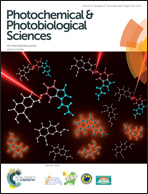PAMAM G4.5-chlorin e6 dendrimeric nanoparticles for enhanced photodynamic effects†
Abstract
There is currently great interest in the development of efficient and specific carrier delivery platforms for systemic photodynamic therapy. Therefore, we aimed to develop covalent conjugates between the photosensitizer chlorin e6 (Ce6) and PAMAM G4.5 dendrimers. Singlet oxygen generation (SOG) efficiency and fluorescence emission were moderately affected by the covalent binding of the Ce6 to the dendrimer. Compared to free Ce6, PAMAM anchored Ce6 displays a much higher photodynamic effect, which is ascribable to better internalization in a tumor cell model. Intracellular fate and internalization pathway of our different compounds were investigated using specific inhibition conditions and confocal fluorescence microscopy. Free Ce6 was shown to enter the cells by a simple diffusion mechanism, while G4.5-Ce6-PEG internalization was dependent on the caveolae pathway, whereas G4.5-Ce6 was subjected to the clathrin-mediated endocytosis pathway. Subcellular localization of PAMAM anchored Ce6, PEGylated or not, was very similar suggesting that the nanoparticles behave similarly in the cells. As a conclusion, we have demonstrated that PEGylated G4.5 PAMAM-Ce6 dendrimers may offer effective biocompatible nanoparticles for improved photodynamic treatment in a preclinical tumor model.


 Please wait while we load your content...
Please wait while we load your content...